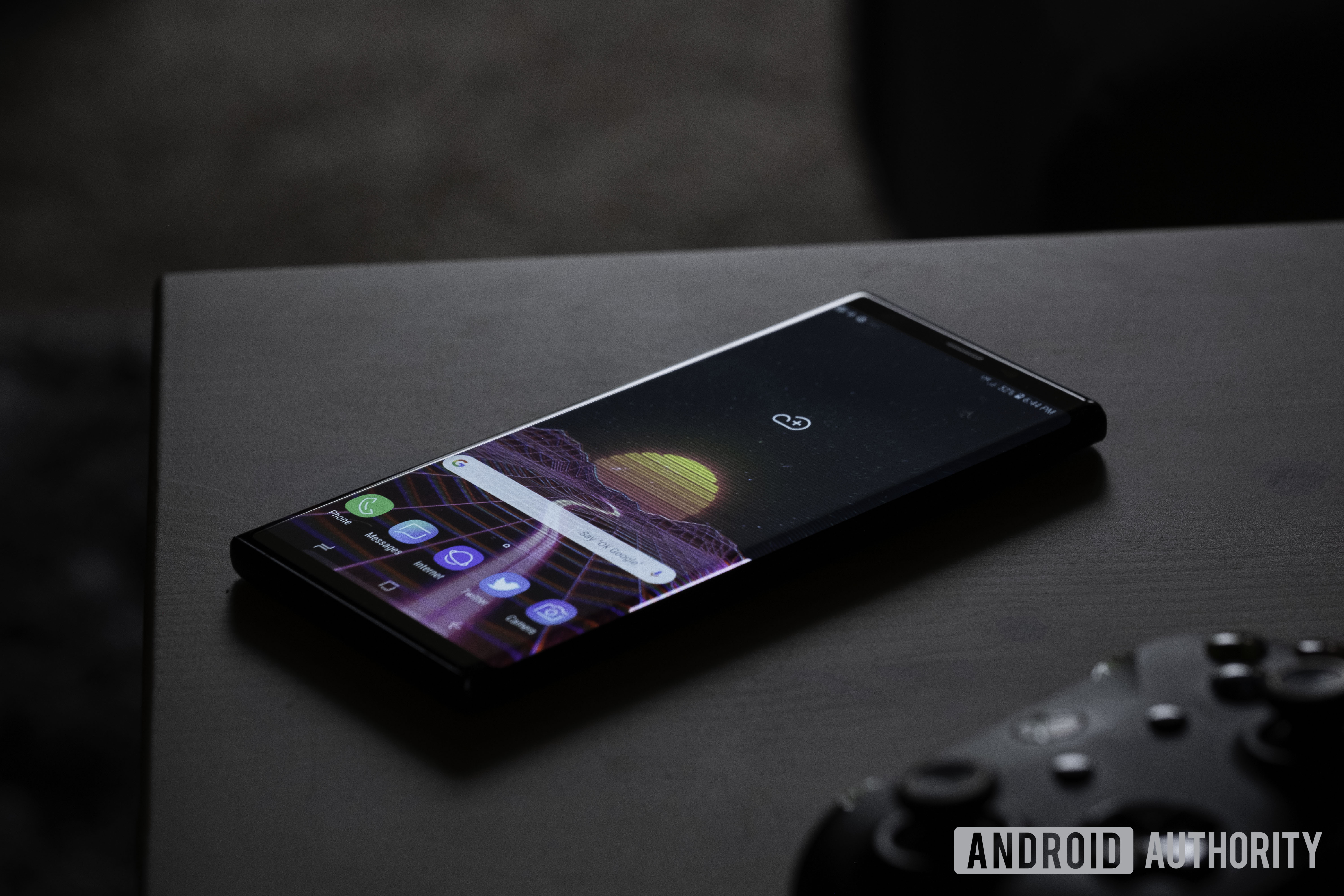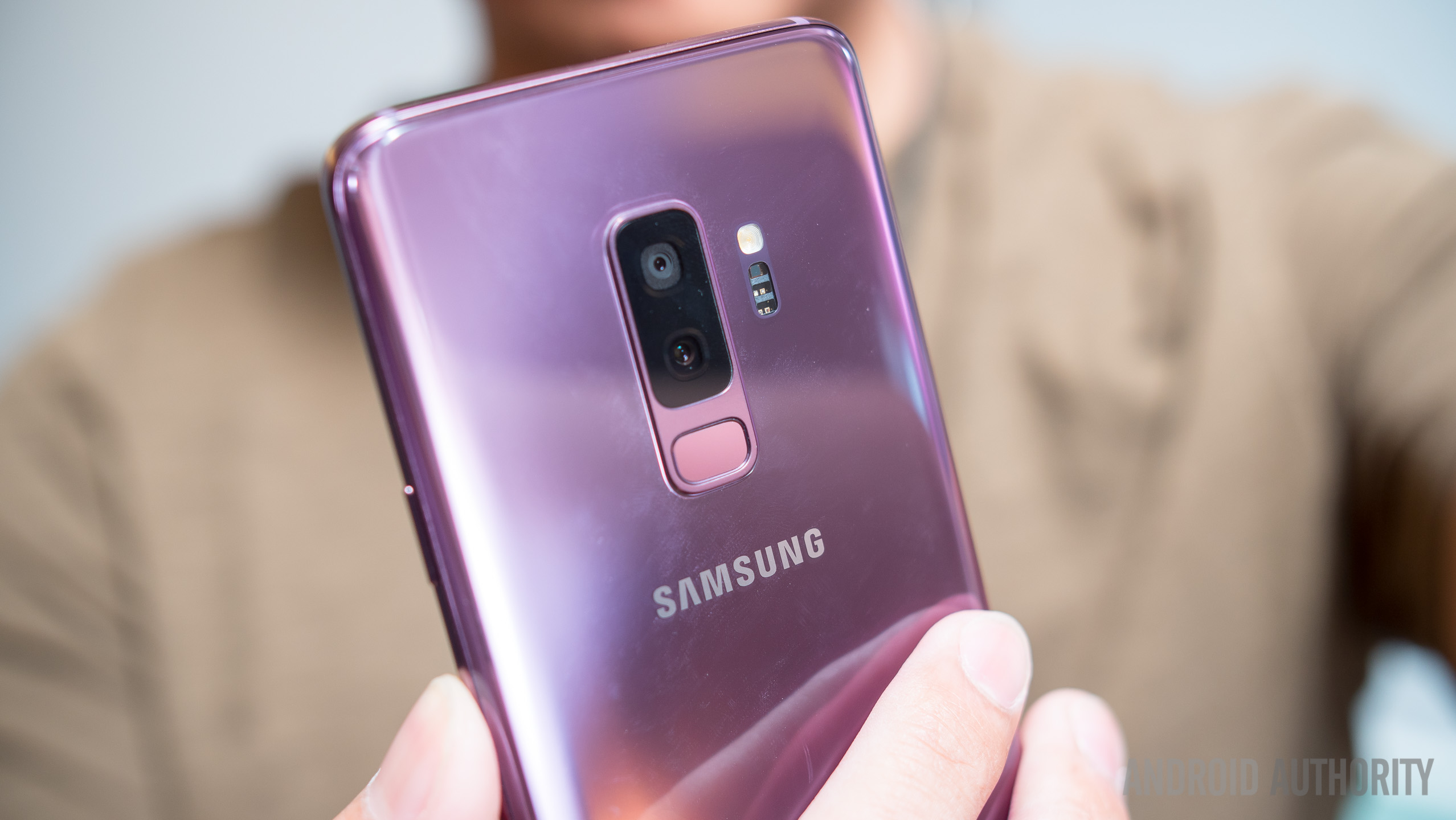To a lot of people, Samsung just makes flagship devices like the Galaxy S9 and the Galaxy Note 9. However, it also makes a range of mid-tier devices with its “J” and “A” series. The “J” phones are the more competitively priced and the “A” range is designed to be more premium. I recently got hold of a Samsung Galaxy A7 (2018) because I wanted to run Speed Test G on it and its Exynos processor. I was so impressed, I thought it warranted a full written review!
Samsung Galaxy A7 (2018) design

The first things you may notice about the A7 are the bezels. In an age where flagship devices are all about edge-to-edge displays and getting the highest screen-t0-body ratio possible, the A7 (2018) might seem a little jarring. When I showed the device to a teenager in my family, the first reaction was, “wow, look at the bezels.”
The A7 (2018) has a 10 percent lower screen-to-body ratio than a device like the Galaxy S9 Plus, which is one of the reasons it’s cheaper. Making all those curved edges costs money in the manufacturing process. That doesn’t mean the A7 (2018) is ugly — it isn’t. In fact, if you can see past the bezels, it has a certain elegance, even a premium look and feel.
The device has a 2.5D rear glass back, which means it is a glass sandwich with some kind of toughened plastic frame acting as the filling. The glass on the back can be a fingerprint magnet, or more precisely a finger-smear magnet, but that is par for the course nowadays.

The buttons are fine but the volume keys may be a bit too far up. All the buttons are on the right side and the SIM tray is on the left. My biggest gripe is with the power key — not as a power key, but as a fingerprint reader. It works well as a power button, but it is quite narrow, which means using it for authentication or unlocking isn’t as seamless as other Samsung experiences. Yes, you can wake and unlock the phone using your registered finger on the power button, but not 100 percent of the time. Once it in while it will glitch and you need to try again (or even a third time). I guess we have been spoiled by the high accuracy of existing fingerprint reader technology.
On the bottom edge of the device, there is a headphone jack (hooray), a MicroUSB port (not so much hooray), and a single speaker. The audio is clear and loud and doesn’t suffer from distortion at higher levels.
Samsung Galaxy A7 (2018) display

The A7 (2018) has a 6.0-inch FHD+ Super AMOLED Infinity Display. It is bright, clear, and vivid. The colors are rich, and as usual with AMOLED the blacks are deep. Once you have grown accustomed to the bezels, the vibrancy of the display makes using the Galaxy A7 a pleasure. You might even catch yourself wondering why you need to spend so much money on a flagship, when devices like this exist in the mid-range.
There is no physical home button, so on-screen navigation is the order of the day, something that’s been the Samsung way for quite a while now. The 6.0-inch display offers a screen resolution of 2,220 x 1,080 (FHD+), which is actually the default resolution for flagship devices like the S9 and Note 9 (although they can go higher). The display has a 18.5:9 aspect ratio, and a 411ppi density.
Overall the display is certainly a strong plus point for the A7 (2018).
See also: The best displays of 2018
Samsung Galaxy A7 (2018) software

The A7 (2018) comes with Android 8.0 Oreo and Samsung Experience 9.0. If you are familiar with Samsung’s skin and UI then you will feel right at home here. Because of the unifying nature of the Samsung Experience, the UI looks and responds exactly like a bigger flagship. When I put the Note 9 next to the A7 it is hard to tell them apart from a UI perspective. The settings menu is the same, the Samsung icons are the same, and the theme is the same.

One thing missing compared to its bigger siblings is Bixby Voice. While Bixby Home is present (swiping left from the home screen) the voice assistant isn’t included and there is no dedicated Bixby button. I guess Samsung considers Bixby a luxury for flagship owners. The snarky side of me is tempted to say the lack of Bixby voice is another reason to buy the A7 (2018), but I shall resist! The device still has AI functionality, though — you can access Google Assistant by long pressing on the home key.
Samsung Galaxy A7 (2018) performance
The A7 (2018) uses the 14nm Exynos 7885 processor. It has an octa-core CPU with two 2.2GHz Cortex-A73 CPU cores and six 1.6GHz Cortex-A53 cores. For gaming, there is good news and bad news. The 7885 features an Arm Mali-G71 GPU. The G71 is an advanced GPU using Arm’s latest Bifrost GPU architecture.
Unfortunately the G71 can be configured by chipmakers like Samsung to including anything from 1 to 32 shader cores. The Exynos 8895 in the Galaxy S8 and Note 8, has a G71 GPU with 20 shader codes. The Exynos 7885 has two. That said, I tested the device with both Asphalt 9 and PUBG Mobile (using the Medium graphics settings) and found the gameplay to be smooth.

The Exynos 7885 also has a built-in LTE modem which supports 2G, 3G and 4G, with LTE download speeds reaching 600Mbps. There is also a nifty Image Signal Processor (more on that in the camera section). On board, there is also 4GB of RAM (6GB on some models), 64GB of internal storage (128GB models available) and a microSD card slot.
For those who like benchmark numbers, the A7 (2018) scored 1524 on Geekbench’s single-core tests and 4379 on its multi-core tests. That puts in into the same ballpark as a Galaxy S7 with a Snapdragon 820 processor. For AnTuTu, which also tests the GPU, the score was 123,302. The AnTuTu score puts the A7 (2018) in the same general area as a flagship device from early 2016.
Samsung Galaxy A7 (2018) battery
The 3,300mAh battery in the A7 (2018) is larger than the battery in the Samsung Galaxy S9 and certainly big enough to give you all-day battery life. According to my testing, you should get at least six hours of screen-on time per charge. That number will increase if you mainly do less demanding tasks like watching YouTube. If you enjoy a bit of 3D gaming, then no fear, five hours minimum. Remember, screen brightness can dramatically change the battery life. If you bump up the brightness to max, expect to shave at least an hour off of all those numbers.
Samsung Galaxy A7 (2018) camera

The camera on the A7 (2018) is a story of simultaneous brilliance and woeful inadequacy. It is brilliant in that it has three cameras — one for normal photos, one for wide-angle shots, and one for depth information. It is brilliant in that the depth camera adds the ability to alter the depth of field while taking a shot, and afterwards. It is brilliant in that the main camera has a 24MP sensor and an f/1.7 aperture, which is great for low-light.
It is woefully inadequate in that the wide-angle camera is just 8MP. It is inadequate because it lacks OIS. It is inadequate because it can only record FHD at 30fps.
Related: Best of Android 2018: The best cameras
Maybe “woefully inadequate” is harsh — this isn’t a premium device — but Samsung has managed to raise the standard with the A7 to a tantalizing level, only to fumble the details. For daily use, there is little bad to say about the main 24MP camera. The colors are true, the dynamic range is good, and the HDR functions work well.
However, the 8MP wide-angle camera is just a little too wide. The pictures often suffer from barrel distortion and the slower f/2.4 aperture isn’t as good in low light.


The third camera is for depth information. It uses a 5MP sensor and an aperture of f/2.2. Those numbers aren’t so important as the purpose of this camera is to enable the depth-of-field functions. The inclusion of a bokeh mode is certainly a plus for the A7, as it is often a feature reserved for more premium devices. While the effect isn’t as precise or advanced as flagship devices, it is nonetheless useful and fun to play with.


Having opted for an 8MP wide-angle camera on the back, there is some redemption for selfie lovers. The A7 (2018) has a 24MP front-facing camera! There is a f/2.0 lens and lots of computational photography options, including bokeh selfies, beauty mode, pro-lighting (for “a more glamorous look and feel”), AR emoji, and wide-selfie, which is basically a panorama mode for the front-facing camera.
It’s not like the 8MP sensor and the occasional barrel distortion on the wide-angle camera ruins the camera experience. Overall the A7 (2018) packs a solid setup backed by lots of interesting trickery from the software.
Here are some more sample photos so you can judge for yourself. If you want to see the full resolutions images you can find them here.

Samsung Galaxy A7 (2018) specs
| Samsung Galaxy A7 (2018) | |
|---|---|
| Display | 6.0-inch Super AMOLED 2,220 x 1,080 (FHD+) resolution |
| SoC | Exynos 7885 Octa (14 nm), 64-bit CPU Octa-core (2 x 2.2GHz Cortex-A73 & 6 x 1.6GHz Cortex-A53) |
| GPU | GPU Mali-G71MP2 |
| RAM | 4 or 6GB |
| Storage | 64 or 128GB MicroSD card slot |
| Cameras | Rear cameras: Triple camera: 24MP (F1.7) + 5MP (F2.2) + 8MP (F.24) Flash Front camera: 24MP sensor, f/2.0 aperture, LED flash |
| Battery | 3,300mAh |
| Network | 2G: - GSM850, GSM900, DCS1800, PCS1900 3G UMTS - B1(2100), B2(1900), B4(AWS), B5(850), B8(900) 4G FDD LTE - B1(2100), B2(1900), B3(1800), B4(AWS), B5(850), B7(2600), B8(900), B12(700), B13(700), B17(700), B20(800), B28(700), B66(AWS-3) 4G TDD LTE - B38(2600), B40(2300), B41(2500) |
| Connectivity | MicroUSB 3.5mm headphone jack Bluetooth 5 (LE up to 2 Mbps) Wi-Fi: 802.11 a/b/g/n/ac 2.4G+5GHz, VHT80 GPS, Glonass, Beidou |
| Software | Android 8.0 Samsung Experience 9.0 |
| Dimensions and weight | 159.8 x 76.8 x 7.5mm 168g |
| Colors | blue, black, gold |
Pricing and final thoughts

Overall the Samsung Galaxy A7 (2018) is a better than average mid-range device. It has a great Super AMOLED screen and an intriguing triple camera setup. The battery life is good and it has a headphone jack! The dual-core GPU could potentially be worrisome to gamers, but if you are more of Candy Crush kind of person, you have nothing to worry about.
If the A7 (2018) doesn’t tempt you, plenty of other mid-range phones have solid chipsets and good cameras, including the Xiaomi Mi A2, Nokia 7.1 Plus, Honor Play, Asus Zenfone 5Z, Moto G6 Plus, or of course the flagship spec’d Pocophone F1.
The Samsung Galaxy A7 (2018) is available in blue, black, and gold for 279 euros (~$317) in Europe and 249 pounds (~$315) in the U.K. Those prices are dependent on various seasonal discounts. It won’t be coming officially to the U.S. but you can find it on Amazon!
from Android Authority https://ift.tt/2Li12ob



0 comments:
Post a Comment